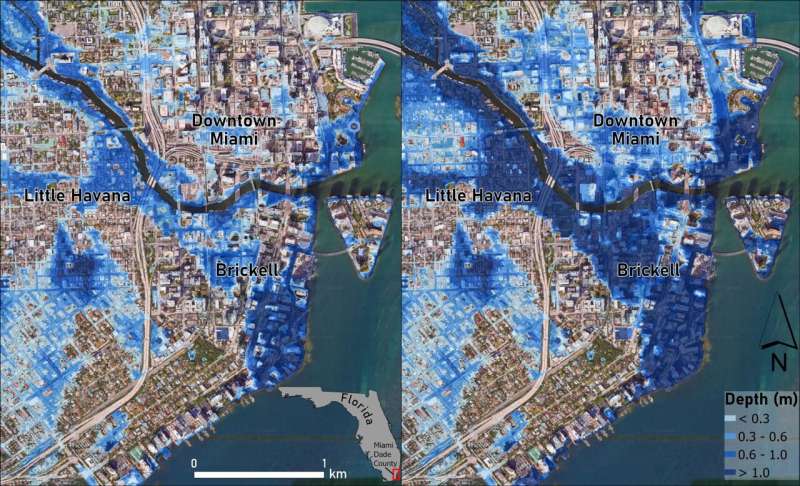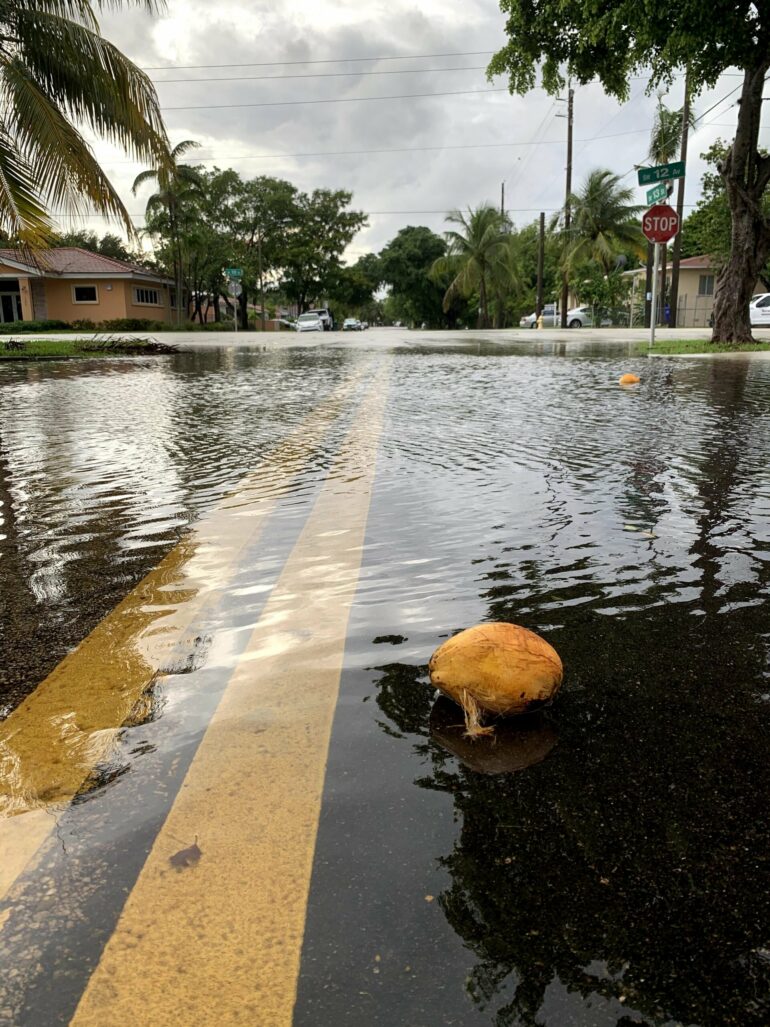A new study that examines both the physical and socioeconomic effects of sea-level rise on Florida’s Miami-Dade County area finds that in coming decades, four out of five residents may face disruption or displacement, whether they live in flood zones or not.
As inundation spreads, the effects will be felt predominantly by lower-income people as habitable areas shrink and housing prices rise, says the study. Only a small number of affluent residents will be able relocate from low-lying or waterfront properties, while many others without sufficient means may be trapped there, it says.
The study was just published in the journal Environmental Research Letters.
“Most studies focus on the direct effects of inundation,” said lead author Nadia Seeteram, a postdoctoral researcher at Columbia University’s Lamont-Doherty Earth Observatory. “Here, we were able to look at flooding on a very granular level, and add in other vulnerabilities.”
The study combines building-by-building projections of flooding caused by direct sea-level rise, rainfall or storm surge with fine-grained demographic data to determine how residents will be affected. Along with flood maps, the researchers used U.S. Census Bureau data to chart economic and social factors that would make people more or less vulnerable, including age, race, level of education, income and status of employment, and whether they owned or rented their homes, among other measures. They then divided the population into four categories.
With a one-meter sea-level increase—a middle-of-the-road scenario for the end of this century—56% of the population, primarily on higher ground, could face pressures to relocate, they say. The researchers call these people “displaced.”
The next largest group they labeled the “trapped”—some 19% of the population, living in chronically flooded territory, but without the means to flee to safer nearby ground. About another 19% would be “stable,” according to the researchers—living in areas not prone to flooding and able to remain there. Just 7%—basically the wealthiest, which the researchers labeled as “migrating”—would be directly exposed to flooding in waterfront or low-lying areas, but able to move to safer spots within the metro area.

Current potential flood exposure (blue areas) in downtown Miami (left panel) and with one meter of sea-level rise. Deeper blues represent greater depth. © Seeteram et al, Environmental Research Letters, 2023
Not surprisingly, the study says that if sea levels rise even more than a meter, direct flooding, not economic pressures, will become the dominant force affecting residents. At two meters—fairly high amid the current range of estimates, but not out of the question—about 55% of the population will be directly inundated through a combination of high sea level and, to an increasing extent, rainfall. Under this scenario, 49% of the population would become trapped, and 25% displaced. Only 8% would be classified as stable.
“This is where it gets to be more drastic, more existential,” said Seeteram, who did much of the research during her Ph.D. studies at Florida International University. In either scenario, she said, the results would include potential depopulation of the area and devaluation of flooded properties, as people flee to safer inland regions. This could make it increasingly difficult for authorities to collect taxes to fund adaptations of infrastructure to keep the ocean at bay—a circular process that could send Miami-Dade into an increasingly dire downward spiral, both physical and fiscal.
The study does not look at how many people are currently being affected by flooding, either directly or indirectly. But floods have already become a routine part of life, as monthly peaks in tides percolate up through the sewers during so-called sunny day flooding, and rain with nowhere to drain pools in streets.
The kind of flash flooding in New York City that made big news after a big storm at the end of September would be viewed as just another day in parts of Miami during the May-October wet season, said Seeteram. A still unpublished survey by Seeteram and colleagues indicates that nearly three quarters of Miamians say they have been personally affected by flooding from rainfall in one way or another.
There are also some indications that so-called climate gentrification—the displacement of lower-income people from higher-elevation areas predicted by the study—is already taking place. For instance, in the last few years, the Little Haiti neighborhood, a relatively lofty 10 feet above sea level, has seen a sudden surge in development and property values, worrying the largely Black residents that they may not be able to remain.
Study co-author Katharine Mach of the University of Miami said there is “a great, raging debate” about whether climate gentrification is underway. “I suspect it is already happening,” she said. However, she said, at least for now, other factors may be playing larger roles in rapidly shifting real-estate values, including longtime pro-development policies and what she calls “real-estate tourism,” with speculators snapping up relatively inexpensive properties in a still booming region.
“The question is, what fraction [of rising prices] can you put on climate?” she said. She pointed out that real-estate prices are also going up in low-lying and waterfront areas, but not as fast as in less flood-prone areas—one possible indicator that predicted sea-level rise is playing a role in buyers’ decisions.
Seteeram said the projections in the new study may not necessarily come to pass, at least with lower estimates of sea-level rise; it depends on how the metro area confronts the problems in coming years. If it revamps infrastructure to lessen flooding and takes other measures, that could blunt the effects, she said. “We could see different kinds of housing development, to make the population denser in some areas, or more climate resilient. But then you would have to see what the intersection would be with affordability for a lot of people.”
More information:
Nadia A Seeteram et al, Modes of climate mobility under sea-level rise, Environmental Research Letters (2023). DOI: 10.1088/1748-9326/acfe22
Provided by
Earth Institute at Columbia University
This story is republished courtesy of Earth Institute, Columbia University http://blogs.ei.columbia.edu.
Citation:
Rising seas will tighten vise on Miami, even for people who are not flooded, says study (2023, October 16)



